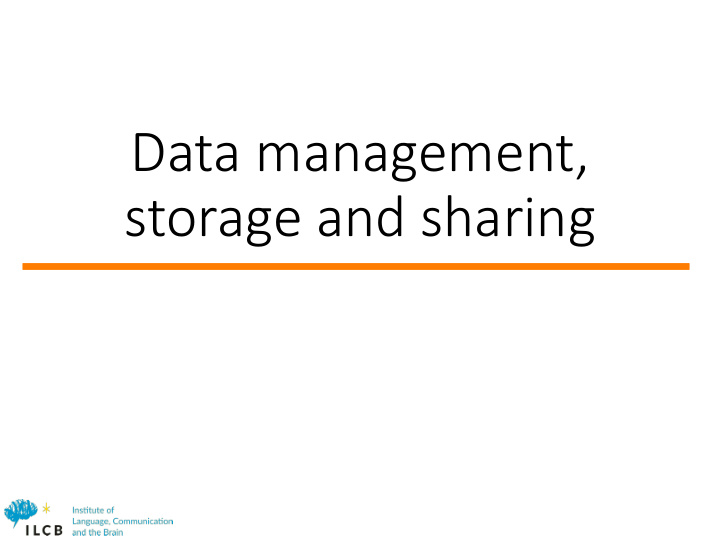



Data management, storage and sharing
Managing data at institute-level: an example Plateforms MRI neuroimaging Mouse Heterogeneous data • Anatomical • Diffusion Rat Multiple sources • Functional • Quantitative Marmoset Multiple scales • … Macaque Large quantities (~150To) Optical Imaging • Bi-photon microscopy Baboon Large need of data processing • Confocal microscopy • Mesoscopic optical imaging Chimpanzee • Spectroscopy • Laser doppler flowmetry Human • Optical coherence tomography • Histology / tracing Clinical Microscopic Electrophysiology EEG/MEG • What Mesoscopic • Multi-electrodes array Large international databases • SIngle cell recordings management for Macroscopic • Deep brain stimulation recordings Human such an amount Connectome Project and variety of NeuroBioTools In Vivo • Genomics data ? • Transcriptomics Post-mortem
Where’s my data ? « On a portable hard drive. My PhD student has got it. I’ll email him» Non secure and unreliable storage. No backup. Major risk: Complete data loss Other risks: loss of associated data and impossibility to reprocess. « On a workstation in the experimental room. From time to time I make a copy of the hard drive. » Non secure storage. Random backup. Risk: data loss Other risks: loss of associated data and impossibility to reprocess. « On a (professional level) storage server » Secure storage, guaranteed backup Can we find the data, can we proceed to new analyses ?
Rationalizing data magement. Goals and motivations To eliminate all possibility of data loss
Rationalizing data magement. Goals and motivations To eliminate all possibility of data loss To offer an easy and reliable access to all data using specifric queries databasing, indexation
Rationalizing data magement. Goals and motivations To eliminate all possibility of data loss To offer an easy and reliable access to all data using specifric queries To ease or automate data processing Formatage / standardisation du stockage
Rationalizing data magement. Goals and motivations To eliminate all possibility of data loss To offer an easy and reliable access to all data using specifric queries To ease or automate data processing Reduce costs
Rationalizing data magement. Goals and motivations To eliminate all possibility of data loss To offer an easy and reliable access to all data using specifric queries To ease or automate data processing Reduce costs Universal formatting of data To facilitate data sharing between researchers, and/or journals requiring an access to experimental data
Rationalizing data magement. Goals and motivations To eliminate all possibility of data loss To offer an easy and reliable access to all data using specifric queries To ease or automate data processing Reduce costs To facilitate data sharing between researchers, and/or journals requiring an access to experimental data To propose a Data Management Plan to researchers
Rationalizing data magement. Goals and motivations To eliminate all possibility of data loss To offer an easy and reliable access to all data using specifric queries To ease or automate data processing Reduce costs To facilitate data sharing between researchers, and/or journals requiring an access to experimental data To propose a Data Management Plan to researchers To promote and facilitate reproducible and open science
Rationalizing data magement. Goals and motivations To eliminate all possibility of data loss To offer an easy and reliable access to all data using specifric queries To ease or automate data processing Reduce costs To facilitate data sharing between researchers, and/or journals requiring an access to experimental data To propose a Data Management Plan to researchers To promote and facilitate reproducible and open science
Rationalizing data magement. Goals and motivations To eliminate all possibility of data loss To offer an easy and reliable access to all data using specifric queries To ease or automate data processing Reduce costs To facilitate data sharing between researchers, and/or journals requiring an access to experimental data To propose a Data Management Plan to researchers To promote and facilitate reproducible and open science To facilitate scientific projects using heterogeneous multi-modal data, or to facilitate machine learning
The 3 pillars of good data management Storage Indexing Formatting Must guarantee security and Ensures that the data is traceable, Standardised nomenclature defining regular data backup and possibly accessible according to storage and organization of data specific queries based on descriptive and associated metadata. All data must be stored as metadata automatically as possible on Ensures that data can be exchanged storage servers This indexation is usually performed and analysed autonomously via a database engine. No loss Access Sharing Automatic processing
Some solutions exist – many need to be built Example organization A tool to join all databases MR Neuroimaging Bio-informatics Multi-electrod Clinical and electrophysiology demographic data Storage server Storage server Storage server NEO formatting, optimised for BIDS formatting TranSMART database REDCap databse data transfer and sharing Xnat database Python API for automatic (partial) automation of indexation processing
Recommend
More recommend